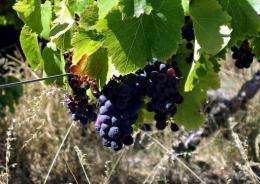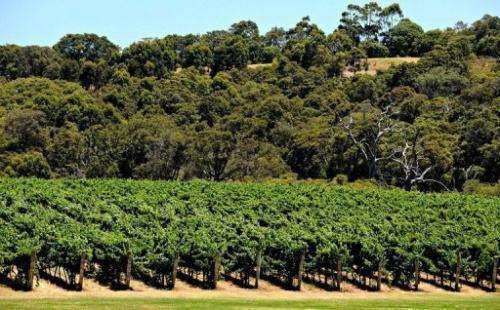Researchers in Australia say they have pinpointed key factors in the early ripening of grapes, providing potential answers for wine growers threatened by global warming.
Researchers in Australia say they have pinpointed key factors in the early ripening of grapes, providing potential answers for wine growers threatened by global warming.
In Australia and Western Europe, there is an abundance of anecdotal evidence linking higher temperatures with earlier grape maturation, a phenomenon that can affect the quality of table wine.
But wine growing and climate change are each highly complex questions.
Until now, no-one has sorted out how the variables -- warming, sunlight, soil moisture and vineyard management -- each play a role in grape maturation.
A team led by Leanne Webb at Australia's national science agency, the Commonwealth Scientific and Industrial Research Organisation (CSIRO), looked at 10 sites in southern Australia where there were highly detailed records, stretching from 1985 to 2009, for all of these factors.
Only at one site -- at Margaret River on Australia's southwestern tip -- did the grapes ripen later. For the others, maturation occurred between six to 34 days earlier.
A 2009 photo shows vineyards in the internationally renowned Margaret River wine region in Western Australia. Researchers in Australia say they have pinpointed key factors in the early ripening of grapes, providing potential answers for wine growers threatened by global warming.
The commonest driver of earlier ripening was higher temperature, deemed a significant factor at seven sites.
Lower soil moisture, particularly in the drought-stricken southeast, was a major factor for earlier harvests at five sites. Drier soils lead to higher levels of a stress hormone called abscisic acid in vine roots, which drives the plant's fruit to earlier ripening.
But vineyard management was also important.
In four sites, pruning and fertilisation methods that lowered crop yields contributed strongly to earlier maturation.
And there may be other technological innovations in these and other sites, such as improved disease and pest control, that could have been a ripening factor, says the study.
Armed with this knowledge, wine growers fretting over global warming have some valuable options, say the authors.
By increasing irrigation or laying down mulch, growers can manage soil moisture -- and by changing their pruning regime, they can alter crop yields.
By choosing root stocks that are less sensitive to plant stress hormones, or trimming leaves, growers can also alter the response of the vine to lower humidity, the paper suggests.
Other crops facing the uncertainties of climate change could be helped by this analytical approach, according to the study, published online on Sunday in the journal Nature Climate Change.
More information: DOI: 10.1038/nclimate1417
Journal information: Nature Climate Change
(c) 2012 AFP






















